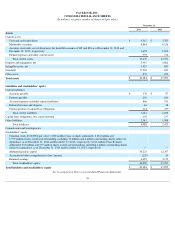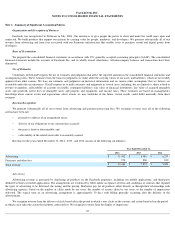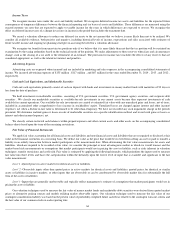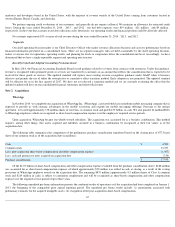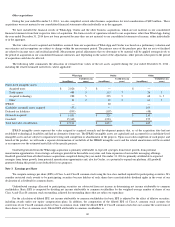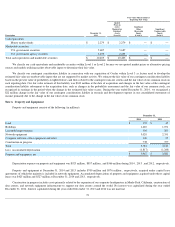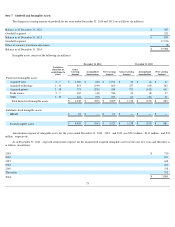Facebook 2014 Annual Report Download - page 68
Download and view the complete annual report
Please find page 68 of the 2014 Facebook annual report below. You can navigate through the pages in the report by either clicking on the pages listed below, or by using the keyword search tool below to find specific information within the annual report.
Income Taxes
We recognize income taxes under the asset and liability method. We recognize deferred income tax assets and liabilities for the expected future
consequences of temporary differences between the financial reporting and tax bases of assets and liabilities. These differences are measured using the
enacted statutory tax rates that are expected to apply to taxable income for the years in which differences are expected to reverse. We recognize the
effect on deferred income taxes of a change in tax rates in income in the period that includes the enactment date.
We record a valuation allowance to reduce our deferred tax assets to the net amount that we believe is more likely than not to be realized. We
consider all available evidence, both positive and negative, including historical levels of income, expectations and risks associated with estimates of
future taxable income and ongoing tax planning strategies in assessing the need for a valuation allowance.
We recognize tax benefits from uncertain tax positions only if we believe that it is more likely than not that the tax position will be sustained on
examination by the taxing authorities based on the technical merits of the position. We make adjustments to these reserves when facts and circumstances
change, such as the closing of a tax audit or the refinement of an estimate. The provision for income taxes includes the effects of any reserves that are
considered appropriate, as well as the related net interest and penalties.
Advertising Expense
Advertising costs are expensed when incurred and are included in marketing and sales expenses in the accompanying consolidated statements of
income. We incurred advertising expenses of $135 million , $117 million , and $67 million for the years ended December 31, 2014 , 2013 , and 2012
,
respectively.
Cash and Cash Equivalents, and Marketable Securities
Cash and cash equivalents primarily consist of cash on deposit with banks and investments in money market funds with maturities of 90 days or
less from the date of purchase.
We hold investments in marketable securities, consisting of
U.S. government securities, U.S. government agency securities, and corporate debt
securities . We classify our marketable securities as available-for-
sale investments in our current assets because they represent investments of cash
available for current operations. Our available-for-
sale investments are carried at estimated fair value with any unrealized gains and losses, net of taxes,
included in accumulated other comprehensive (loss) income in stockholders' equity. Unrealized losses are charged against interest and other income/
(expense), net when a decline in fair value is determined to be other-than-
temporary. We have not recorded any such impairment charge in the periods
presented. We determine realized gains or losses on sale of marketable securities on a specific identification method, and record such gains or losses as
interest and other income/(expense), net.
We classify certain restricted cash balances within prepaid expenses and other current assets and other assets on the accompanying consolidated
balance sheets based upon the term of the remaining restrictions.
Fair Value of Financial Instruments
We apply fair value accounting for all financial assets and liabilities and non-
financial assets and liabilities that are recognized or disclosed at fair
value in the financial statements on a recurring basis. We define fair value as the price that would be received from selling an asset or paid to transfer a
liability in an orderly transaction between market participants at the measurement date. When determining the fair value measurements for assets and
liabilities, which are required to be recorded at fair value, we consider the principal or most advantageous market in which we would transact and the
market-
based risk measurements or assumptions that market participants would use in pricing the asset or liability, such as risks inherent in valuation
techniques, transfer restrictions and credit risk. Fair value is estimated by applying the following hierarchy, which prioritizes the inputs used to measure
fair value into three levels and bases the categorization within the hierarchy upon the lowest level of input that is available and significant to the fair
value measurement:
Level 1 -Quoted prices in active markets for identical assets or liabilities.
Level 2 -
Observable inputs other than quoted prices in active markets for identical assets and liabilities, quoted prices for identical or similar
assets or liabilities in inactive markets, or other inputs that are observable or can be corroborated by observable market data for substantially the full
term of the assets or liabilities.
Level 3 -
Inputs that are generally unobservable and typically reflect management's estimate of assumptions that market participants would use in
pricing the asset or liability.
Our valuation techniques used to measure the fair value of money market funds and marketable debt securities were derived from quoted market
prices or alternative pricing sources and models utilizing market observable inputs. Our valuation technique used to measure the fair value of our
contingent consideration liability was based on the present value of probability-weighted future cash flows related to the contingent earn-
out criteria and
the fair value of our common stock on each reporting date.
64



